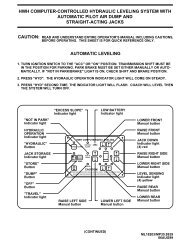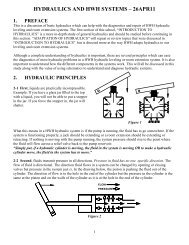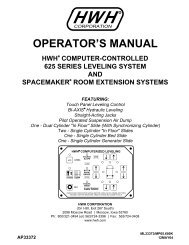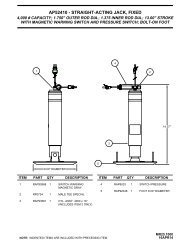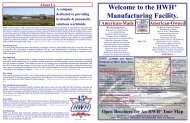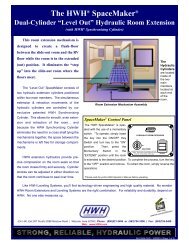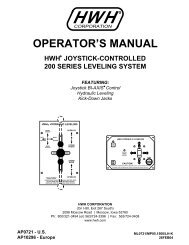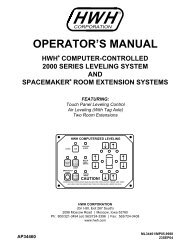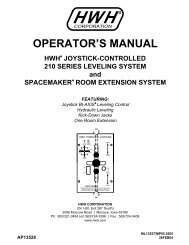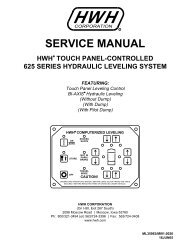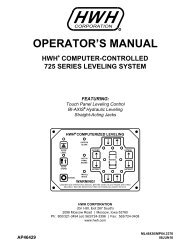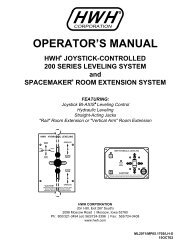AIR SUSPENSIONS AND HWH - HWH Corporation
AIR SUSPENSIONS AND HWH - HWH Corporation
AIR SUSPENSIONS AND HWH - HWH Corporation
- No tags were found...
Create successful ePaper yourself
Turn your PDF publications into a flip-book with our unique Google optimized e-Paper software.
Check the appropriate fuse. If the fuse is ok, then check for + voltage between the appropriate black wire(9300 – Dump & 9301 – Travel) and the white ground wire. If voltage is present, the issue is with the pilotdump equipment and you should contact the vehicle or chassis manufacturer. If voltage is not present,check for voltage on the correct output pin. If voltage is present, there is a problem with the harness wiresor connections. If voltage is not present, the problem is most likely the control box or panel. If the fuse isblown, unplug the 4-pin UML connector and replace the fuse. If the fuse now blows, there is a short in theharness or control box/panel. If the fuse does not blow with the harness unplugged, the problem is with thevehicle pilot dump wiring or equipment. Contact the vehicle or chassis manufacturer.3. <strong>HWH</strong> <strong>AIR</strong> LEVELINGThis discussion will cover the basic <strong>HWH</strong> air leveling systems. This section will not cover the <strong>HWH</strong>Active Air system. The Active Air system will be discussed as an individual subject in the <strong>HWH</strong> onlinetechnical school.3-1 What is air leveling? Very simply, air leveling uses the vehicle’s air suspension to level the vehicle.<strong>HWH</strong> isolates the suspension air bags from the heights control valves. This way <strong>HWH</strong> can control the airbags for leveling. To level the vehicle, air is released from the suspension air bags to lower the vehicle oradded to the suspension air bags to raise the vehicle. This is done using the <strong>HWH</strong> Bi-Axis ® levelingprinciple.Bi-Axis ® leveling. Bi-Axis is working with two corners of the vehicle at a time to level the vehicle side toside and then front to rear. If the left side is low, the right rear and right front corners are raised to level thevehicle side to side. If the front is low, both front corners of the vehicle are raised to level the vehicle.With a motorized vehicle, you always level the vehicle (if needed) side to side before leveling front to rear.All present day air leveling systems incorporate the Bi-Axis four point leveling principle, but the original500 series air leveling system and some early 600 series air leveling systems were three point levelingsystems. That means the two rear corners were controlled independently but the two front corners werecontrolled together. With a four point system, there is a raise, lower and travel valve for each corner of thevehicle. With a three point system, there is only one raise, lower and travel valve for both front corners.This will be explained in greater detail later in the <strong>HWH</strong> Air Leveling section of this lesson.The majority of air leveling systems are installed by the vehicle manufacturer but air leveling can beinstalled on any vehicle with a full air suspension that incorporates height control valves. This is not anormal aftermarket installation but an air leveling system can be installed on an existing vehicle with theapproval of <strong>HWH</strong> <strong>Corporation</strong>. The installer must be approved by <strong>HWH</strong> <strong>Corporation</strong>.Air leveling systems can also be combined with the <strong>HWH</strong> hydraulic leveling systems. This system usesone control box and touch panel. Vehicles equipped with a combination air or hydraulic system gives theoperator the choice of using either the air leveling system or the hydraulic leveling system. If one systemhas been used to level the vehicle, do not use the other system. Example: If the hydraulic system wasused to level the vehicle, do not use the air leveling system unless the hydraulic system has been retracted.Page 10 – 22JUL09



